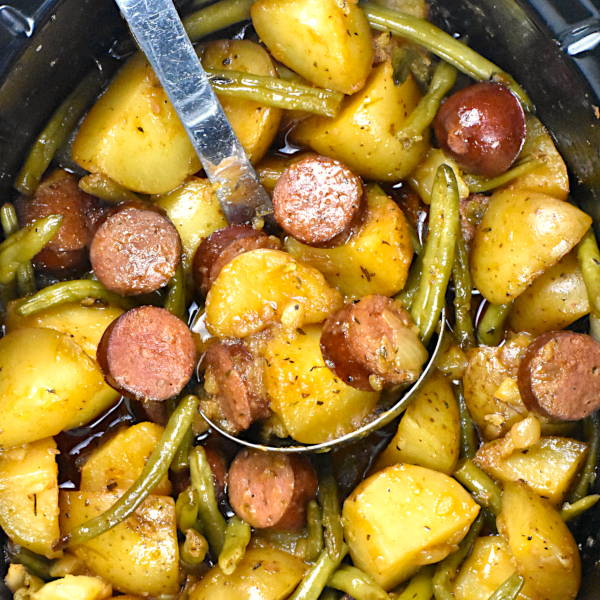They call them Drunken Noodles for a reason. Some say it’s because this fiery Thai stir fry is the perfect cure after a late night out, while others believe it’s so spicy you’ll want an ice-cold beer to cool things down. Whatever the story, it’s one of the most loved street dishes in Thailand.
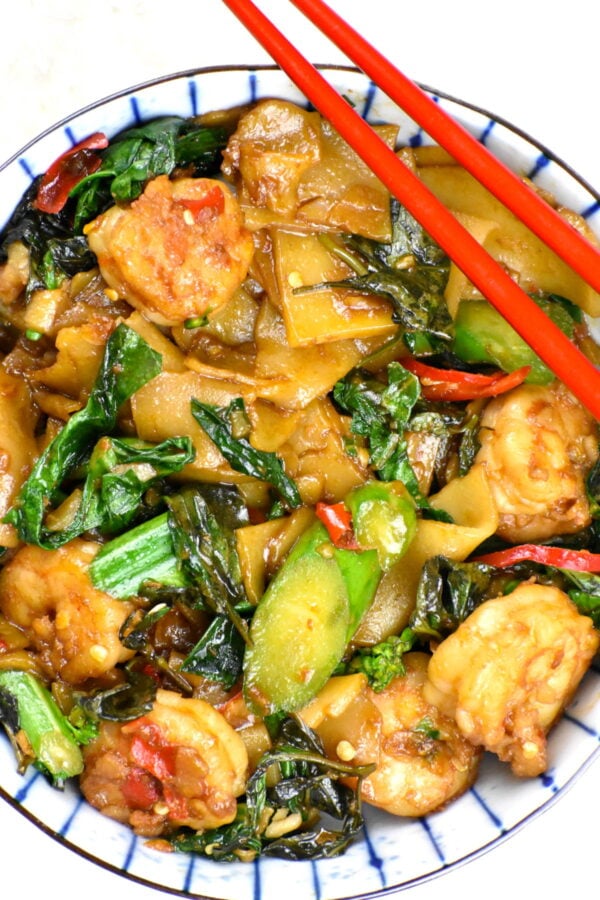
There’s something about Drunken Noodles, also known as Pad Kee Mao. I’m in my happy place whenever there’s a big plate of this famous Thai noodle dish in front of me. Those wide, chewy noodles soak up that fiery, savory sauce filled with garlic, chilies, and Thai basil, making every bite spicy and full of that distinctive basil flavor that’s simply addictive
This is classic Thai street food at its best. The ingredients are simple, but the real secret lies in the technique. It may look and taste like something that takes serious skill, but once you learn a few little tricks, it comes together easily at home. With the right heat, timing, and ingredients, you’ll have a dish that’s every bit as authentic as what you’d find on the streets of Thailand.
What are Drunken Noodles
Drunken Noodles, or Pad Kee Mao (Thai: ผัดขี้เมา), literally translates to “stir-fried drunkard.” In Thai, phat means “stir-fry,” and khi mao means “drunk” or “drunkard.” Despite the name, there’s no alcohol involved, it’s just one of those colorful Thai expressions.
It likely originated in central Thailand, inspired by Chinese-style stir-fried noodles, but evolved into something uniquely Thai with fiery chilies, garlic, and plenty of fresh basil. Compared to its milder cousin Pad See Ew, Pad Kee Mao is bolder, spicier, and more aromatic.
The dish is made with fresh wide rice noodles, tossed quickly over high heat with garlic, chilies, vegetables, and a savory sauce. A final handful of Thai basil gives it that unmistakable fragrance and flavor that ties it all together.
In Thailand, Pad Kee Mao is the kind of dish you’ll find sizzling away at late-night food stalls, cooked fast over high flames by street vendors who know exactly how to get that perfect smoky flavor. It’s meant to be eaten hot, straight from the wok, often with a squeeze of lime or a few extra chilies on the side.
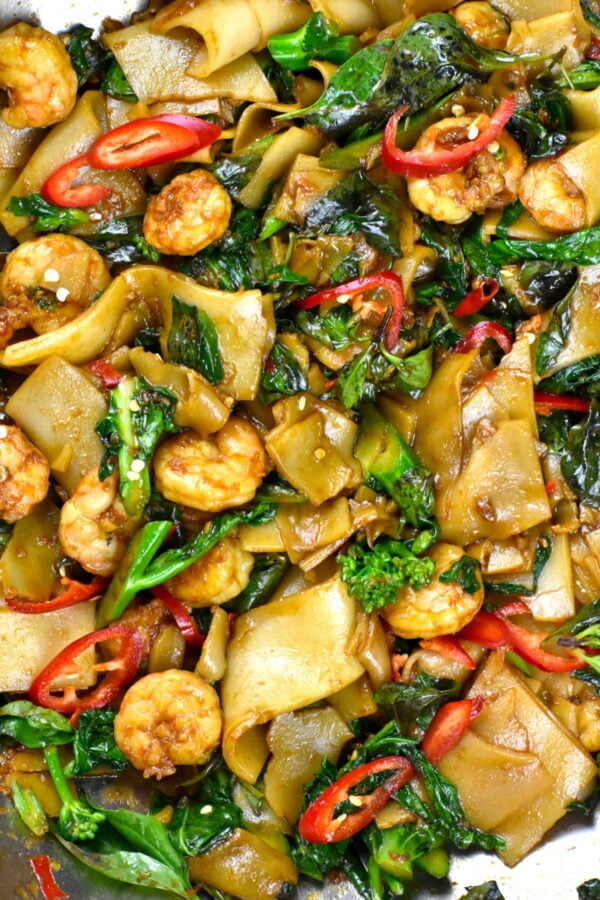
Ingredients Needed
I have included exact ingredient amounts in the recipe card at the end of this post. Here are the things you will need:
- Rice Noodles – Fresh wide rice noodles are best here. They have that chewy texture that makes this dish so authentic. You can find them in the refrigerated section of Asian markets. If you can’t get fresh, use dry wide rice noodles (about 6 ounces). Just soak, boil, and rinse them in cold water before using.
- Shrimp – I’m using shrimp today, but you can also make this with thinly sliced chicken, pork or beef.
- Thai Bird’s Eye Chilies – These tiny chilies bring that fiery heat Drunken Noodles are known for. I usually use 4–5, but you can adjust to your spice level. For a milder dish, remove the seeds or use fewer chilies.
- Garlic – Lots of it! Garlic is the backbone of the flavor here, especially when it hits that hot wok and turns golden and fragrant.
- Chinese Broccoli – Also called gai lan, it adds great texture with its tender leaves and crunchy stems. Slice the stems thin on a diagonal and chop the leaves roughly. You can sub with bok choy.
- Thai Basil – The soul of this dish. It gives that signature aroma and flavor you instantly recognize. Traditionally, Thai Holy Basil is used, but Thai Basil works great and is easier to find. If you can’t find either, regular basil will still taste wonderful.
- Oyster Sauce, Fish Sauce, Soy Sauce & Dark Soy Sauce – This combination creates the perfect balance of salty, umami richness with just a touch of sweetness. The dark soy sauce is optional, but I highly recommend it because it gives the noodles that beautiful color.
- Sugar – Just a small spoon balances all the salty and spicy notes.
- Oil – Any neutral oil works fine, though I like to use one with a high smoke point since this cooks on high heat.
How to Make Authentic Drunken Noodles
Step 1: Marinate the Shrimp. In a small bowl, combine shrimp with fish sauce and garlic. Toss well and set it aside while you prepare the rest of the ingredients. The short marination gives the shrimp a touch of flavor and helps them absorb the sauce better once they hit the wok.
Step 2: Make the Sauce. In another bowl, whisk together oyster sauce, fish sauce, soy sauce, dark soy sauce, and sugar. This mixture will give your noodles that savory, slightly sweet, glossy finish you see in Thai restaurants.

Step 3: Prepare the Noodles. Fresh rice noodles usually come clumped together, so place them on a large plate and warm them briefly in the microwave, stirring every few seconds so they heat evenly. Once they soften, gently pull them apart and divide them into smaller bundles. If you’re using dry noodles, soak and boil about six ounces, then rinse them in cold water to stop the cooking. Set aside until ready to use.

Step 4: Stir-Fry the Aromatics. Heat oil in a large wok or a wide skillet over high heat. Once the oil is shimmering, add the chopped Thai Bird’s eye chilies and garlic. Stir-fry for 20–30 seconds until fragrant. Keep the heat high but don’t let the garlic burn, this is where the base flavor of the whole dish begins.
Step 5: Add the Shrimp. Add the marinated shrimp straight into the wok. Stir-fry for about a minute or two, just until they start turning pink. They’ll finish cooking later with the noodles, so don’t overdo it at this stage.

Step 6: Add the Vegetables. Add all the Chinese broccoli and stir-fry for about 1–2 minutes, just until it starts to soften and the leaves begin to wilt. The greens add freshness and a lovely balance to the heat of the chilies.

Step 7: Add the Noodles and Sauce. Now it’s time for the noodles. Add them to the wok, followed by your prepared sauce. Toss everything together quickly to coat evenly. Once coated, spread the noodles out and let them sit undisturbed for about 45 seconds to 1 minute — this gives them that slight char and smoky flavor that makes real Pad Kee Mao so special. Then give everything one more toss.

Step 8: Add the Thai Basil. Add in the Thai basil leaves and toss everything together for another 30 seconds or so until the basil wilts and releases its wonderful aroma.

Step 9: Serve. Serve immediately with some fresh sliced Thai red chili (if you want it just like me, extra Thai Hot) while it’s hot and glossy. The noodles should be tender with just a hint of char, the shrimp perfectly cooked.
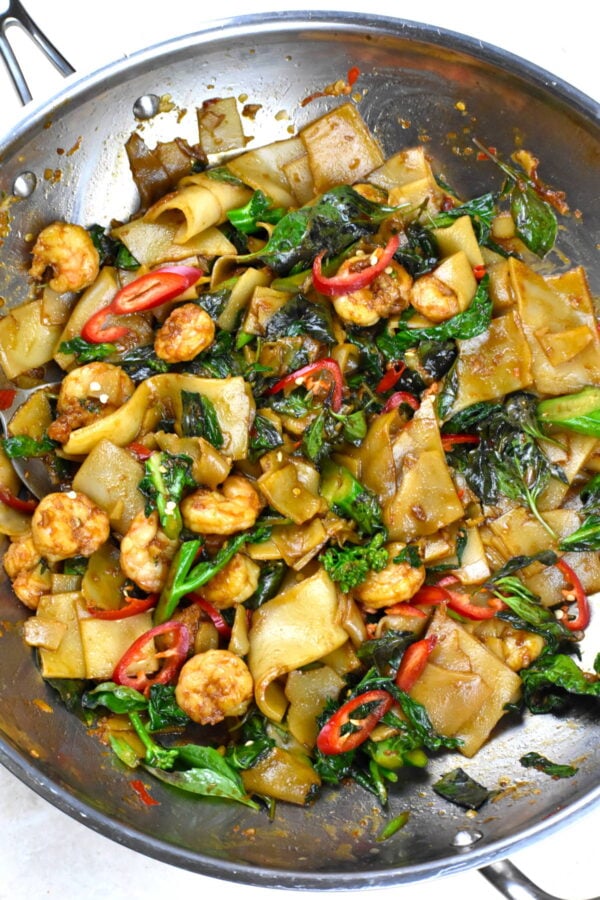
Alpana’s Tips and Notes
- Use high heat: This is one of the most important parts of cooking Pad Kee Mao. Keep the heat as high as your stove allows so the noodles sear instead of steam. That’s what gives them that authentic wok flavor.
- Don’t overcrowd the wok: If your wok or skillet is on the smaller side, cook in batches. Too many ingredients at once will cool the pan down and make the noodles soggy.
- Get that little char: After adding the sauce, let the noodles sit for a short moment before tossing again. This helps them develop a beautiful light char and a subtle smokiness that’s the hallmark of real Thai street noodles.
- Adjust the spice: Thai Bird’s eye chilies are quite fiery, so start with fewer and build up. For a gentler heat, remove the seeds before cooking.
- Make it saucier: If you prefer more sauce clinging to your noodles, add a splash of water, broth, or even a bit more soy and oyster sauce toward the end.
- Try other proteins: Chicken and pork are the most traditional, but beef, shrimp, or even a mix of seafood all taste amazing in this dish.
- Add more veggies: Bell peppers, onions, mushrooms, or even baby corn work beautifully here and add color and crunch.
- Work quickly: Once the noodles and sauce go in, the dish cooks fast. Have all your ingredients prepped and ready to toss in before you start, it’s the secret to getting that smooth, restaurant-style finish.
Serving Suggestions
Drunken Noodles are best served right away, straight from the wok while they’re piping hot and glossy. That’s when the basil aroma is at its peak and the noodles still have that lovely chewy texture.
I love pairing them with my Asian Cucumber Salad, which adds a cool, crisp contrast to the spice. A few spring rolls or even some Thai Papaya Salad make great additions for a full Thai-inspired spread.
And let’s be honest, this fiery, aromatic dish practically begs for something cold on the side. A chilled beer is the perfect match here, cutting through the spice and making every bite even more satisfying.
If you enjoy extra heat, serve a small bowl of sliced Thai chilies in fish sauce on the side, just like they do in Thailand.
Leftovers and Storing
Pad Kee Mao is at its absolute best when eaten fresh. The noodles lose their chewy bite as they sit, and the basil flavor fades a little once cooled.
If you do have leftovers, store them in an airtight container in the refrigerator for up to 2 days. To reheat, warm them in a skillet over medium heat with just a splash of water or a drizzle of oil to loosen the noodles and revive the sauce. Avoid microwaving too long, as it can make the noodles rubbery.
This dish doesn’t freeze well, so it’s one to enjoy fresh! Trust me, there won’t be much left anyway!

They call them Drunken Noodles, and after a plate of these fiery, saucy noodles, you might just start acting like it. The good news? No hangover — just pure Thai happiness in a bowl.
Thai Drunken Noodles, on our Gypsy Plate… enjoy!

More great Thai Recipes:
Green Chicken Curry
Crying Tiger Beef
Thai Cashew Chicken
Pad Krapow Gai
Massaman Beef Curry
Red Shrimp Curry
Thai Fried Rice
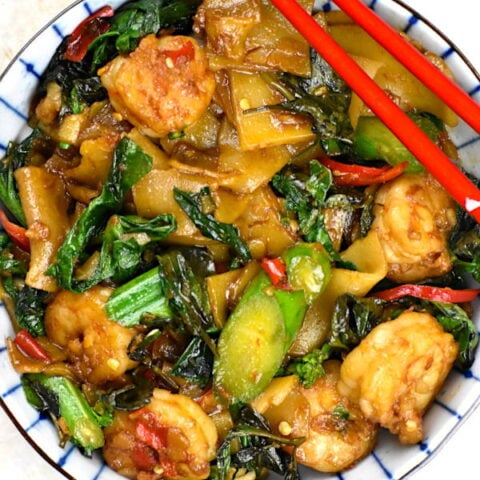
Thai Drunken Noodles (Pad Kee Mao)
These Drunken Noodles, or Pad Kee Mao, are a bold Thai stir fry with fresh chili, basil, and wide rice noodles — spicy, savory, and downright addictive!
Ingredients
To Marinate Shrimp
- 8oz shrimp, deveined and tail-on (see note 1)
- 1 teaspoon fish sauce
- 1 garlic clove, grated
Pad Kee Mao Sauce
- 2 tablespoons oyster sauce
- 1 tablespoon fish sauce
- 1 tablespoon soy sauce
- 1 teaspoon dark soy sauce
- 1 teaspoon sugar
Drunken Noodles Stir Fry
- 1 pound fresh wide rice noodles (see note 2)
- 2 tablespoons oil
- 4-5 red Thai Bird’s eye chili, or to taste, + more for garnish (see note 3)
- 6-7 garlic cloves, finely chopped
- 6oz Chinese broccoli (or other Asian greens like pak chok or bok choy) (see note 4)
- 2 cups Thai basil or Thai holy basil leaves (see note 5)
Instructions
- Marinate the Shrimp: In a small bowl, combine shrimp with fish sauce and grated garlic. Toss well and let them sit while preparing the rest of the ingredients.
- Make the Sauce: In another bowl, whisk together oyster sauce, fish sauce, soy sauce, dark soy sauce, and sugar until well combined. Set aside.
- Prepare the Noodles: Rice noodles are often sold clumped together and can be difficult to separate at first. Gently warm them in the microwave until they soften, or they may tear when pulled apart. Divide into 3 to 4 smaller bundles and spread them out on a large plate. Microwave briefly, stopping every 30 seconds to move them around so they heat evenly, until they loosen up. Once they start to soften, carefully pull the noodles apart.
- Stir-Fry the Aromatics: Heat oil in a large wok or skillet over high heat. Add the chopped Thai Bird’s eye chilies and garlic, and stir-fry for 20–30 seconds until fragrant. Keep the heat high, but don’t let the garlic burn.
- Add Shrimp: Add the marinated shrimp directly to the wok. Stir-fry for about 1–2 minutes until they start turning pink but aren’t fully cooked yet.
- Add Vegetable: Add all the Chinese broccoli and stir-fry for about 1–2 minutes, just until it starts to soften and the leaves begin to wilt. The moisture from the greens helps keep the shrimp juicy while everything cooks together.
- Add Noodles and Sauce: Add the softened rice noodles to the wok, followed by the Pad Kee Mao sauce. Toss everything together to coat evenly, then let the noodles sit for about 45 seconds to 1 minute to char lightly. This gives them that signature smoky flavor before giving everything a few tosses.
- Add Thai Basil: Toss in the Thai basil leaves and continue stirring for another 30 seconds to 1 minute, just until the basil is wilted and aromatic.
- Serve: Serve immediately, topped with extra sliced Thai chilies if you like it spicier. The noodles should be glossy, slightly smoky, and full of bold flavor.
Notes
- Shrimp can be swapped with chicken, beef, or pork. Just make sure the meat is sliced thin and against the grain so its turns juicy and tender.
- Fresh wide rice noodles work best for this dish and can usually be found in the refrigerated section of Asian grocery stores. If using dry noodles, measure about 6 ounces. They’ll need to be soaked, boiled, and then rinsed in cold water before adding to the recipe. The texture won’t be quite the same as fresh, but they’ll still taste great.
- Thai Bird’s eye chilies are quite hot, so adjust the amount based on your spice preference. Using 4 to 5 gives the dish a noticeable kick without overpowering the other flavors. For a milder version, use fewer chilies or remove the seeds before adding.
- Asian broccoli and other greens can be easily found in Asian grocery store. Slice the stems thin on a slight diagonal and give the leaves a rough chop.
- Thai Basil: Has a light aniseed flavor that sets it apart from regular basil. Traditionally, Drunken Noodles are made with Thai Holy Basil, but most restaurants outside Thailand use Thai Basil instead. If you can’t find it, regular basil works just fine as a substitute.
Nutrition Information
Yield 4 Serving Size 1Amount Per Serving Calories 428Total Fat 17gSaturated Fat 4gTrans Fat 0gUnsaturated Fat 11gCholesterol 145mgSodium 2065mgCarbohydrates 42gFiber 3gSugar 3gProtein 26g
Nutrition information is automatically calculated, so should only be used as an approximation.

Welcome to GypsyPlate! I'm Alpana, former worldwide tour manager and professional caterer, now full time blogger. I love exploring cuisines from around the world, and my recipes have been featured on sites such as MSN, Parade, Brit + Co, CNET and AOL. You can explore my entire collection of sortable recipes in my Recipe Index or learn more about me here.
Get griddling! Try these Blackstone Recipes!
Never miss a recipe!
Join the GypsyPlate mailing list and get easy dinner recipes right in your mailbox. From homestyle comfort food to exotic dishes from around the world.





